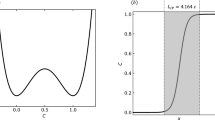Abstract
We study the influence of variations of cross-section on the drying dynamics by pervaporation in microfluidic channels surrounded by water-permeable polydimethylsiloxane (PDMS) walls. Single channels of linearly increasing and decreasing width display similar drying time, but different dynamics towards final drying. Single channels with stepwise increasing or decreasing width show jumps of the drying velocity when the meniscus separating the water-filled and the dry part of the channel crosses the steps. In branched networks, narrower branches tend to dry faster than wider ones. All these observations are rationalised in the framework of a model based on the solution of the diffusion equation of water through PDMS, accounting precisely for the local channel geometry, provided the section variation is slow. This model shows that drying velocity depends strongly on the local channel width at the meniscus location. It captures quantitatively our measurements, except the magnitude of the velocity jumps in channels with steps. Implications and perspectives of this study are discussed in the context of leaf drying by the so-called air seeding mechanism in trees.






Similar content being viewed by others
References
Bacchin P, Leng J , Salmon J. B., Microfluidic evaporation, pervaporation and osmosis: from passive pumping to solute concentration, under review in Chem. Rev
Brodribb TJ, Bienaimé D, Marmottant P (2016) Revealing catastrophic failure of leaf networks under stress. Proc. Natl. Acad. Sci. 113:4865–4869
Brodribb TJ, Powers J, Cochard H, Choat B (2020) Hanging by a thread? Forests and drought. Science 368:261–266
Choat B, Ball M, Luly J, Holtum J (2003) Pit membrane porosity and water stress-induced cavitation in four co-existing dry rainforest tree species. Plant Physiol. 131:41–48
Choat B, Brodribb TJ, Brodersen CR, Duursma RA, López R, Medlyn BE (2018) Triggers of tree mortality under drought. Nature 558:531–539
Cox SJ, Neethling S, Rossen WR, Schleifenbaum W, Schmidt-Wellenburg P, Cilliers JJ (2004) A theory of the effective yield stress of foam in porous media: the motion of a soap film traversing a three-dimensional pore. Colloids Surf. A 245:143–151
Dollet B, Louf JF, Alonzo M, Jensen KH, Marmottant P (2019) Drying of channels by evaporation through a permeable medium. J. R. Soc. Interface 16:20180690
Dollet B, Chagua Encarnación KN, Gautier R, Marmottant P (2021) Drying by pervaporation in elementary channel networks. J. Fluid Mech. 906:A6
Eijkel JCT, Bomer JG, van den Berg A (2005) Osmosis and pervaporation in polyimide submicron microfluidic channel structures. Appl. Phys. Lett. 87:114103
Géraud B, Méheust Y, Cantat I, Dollet B (2017) Lamella division in a foam flowing through a two-dimensional porous medium: A model fragmentation process. Phys. Rev. Lett. 118:098003
Harley SJ, Glascoe EA, Maxwell RS (2012) Thermodynamic study in dynamic water vapor sorption in Sylgard-184. J. Phys. Chem. B 116:14183–14190
Jensen KH, Berg-Sørensen K, Bruus H, Holbrook NM, Liesche J, Schulz A, Zwieniecki MA, Bohr T (2016) Sap flow and sugar transport in plants. Rev. Mod. Phys 88:035007
McCulloh KA, Sperry JS, Adler FR (2003) Water transport in plants obeys Murray’s law. Nature 421:939–942
Noblin X, Mahadevan L, Coomaraswamy IA, Weitz DA, Holbrook NM, Zwieniecki MA (2008) Proc. Natl. Acad. Sci. 105:9140–9144
Ody CP, Baroud CN, de Langre E (2007) Transport of wetting liquid plugs in bifurcating microfluidic channels. J. Colloid Interface Sci. 308:231–238
Ponomarenko A, Vincent O, Pietriga A, Cochard H, Badel E, Marmottant P (2014) Ultrasonic emissions reveal individual cavitation bubbles in water-stressed wood. J. R. Soc. Interface 11:20140480
Randall GC, Doyle PS (2005) Permeation-driven flow in poly(dimethylsiloxane) microfluidic devices. Proc. Natl. Acad. Sci. 102:10813–10818
Stroock AD, Pagay VV, Zwieniecki MA, Holbrook NM (2014) The physicochemical hydrodynamics of vascular plants. Annu. Rev. Fluid Mech. 46:615–642
Tyree MT, Sperry JS (1989) Vulnerability of xylem to cavitation and embolism. Annu. Rev. Plant Physiol. Plant Mol. Biol. 40:19–36
Vincent O, Marmottant P, Quinto-Su PA, Ohl CD (2012) Birth and growth of cavitation bubbles within water under tension confined in a simple synthetic tree. Phys. Rev. Lett. 108:184502
Vincent O, Marmottant P, Gonzalez-Avila SR, Ando K, Ohl CD (2014) The fast dynamics of cavitation bubbles within water confined in elastic solids. Soft Matter 10:1455–1461
Watson JM, Baron MG (1996) The behaviour in water in poly(dimethylsiloxane). J. Membr. Sci. 110:47–57
Wheeler TD, Stroock AD (2008) The transpiration of water at negative pressures in a synthetic tree. Nature 455:208–212
Xu Q, Rossen WR (2003) Effective viscosity of foam in periodically constricted tubes. Colloids Surf. A 216:175–194
Ziane N, Guirardel M, Leng J, Salmon JB (2015) Drying with no concentration gradient in large microfluidic droplets. Soft Matter 11:3637–3642
Ziemecka I, Haut B, Scheid B (2015) Hydrogen peroxide concentration by pervaporation of a ternary liquid solution in microfluidics. Lab Chip 15:504–511
Acknowledgements
We thank Aurélien Caumont, Danièle Centanni and Ludovic Keiser for experimental help. Funding by ANR, under the grant PHYSAP ANR619-CE30-0010-02, is gratefully acknowledged.
Author information
Authors and Affiliations
Corresponding author
Ethics declarations
Conflict of interest
The authors declare that they have no conflict of interest.
Additional information
Publisher's Note
Springer Nature remains neutral with regard to jurisdictional claims in published maps and institutional affiliations.
Rights and permissions
About this article
Cite this article
Chagua Encarnación, K.N., Marmottant, P. & Dollet, B. Pervaporation-induced drying in networks of channels of variable width. Microfluid Nanofluid 25, 71 (2021). https://doi.org/10.1007/s10404-021-02467-2
Received:
Accepted:
Published:
DOI: https://doi.org/10.1007/s10404-021-02467-2




